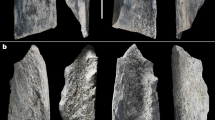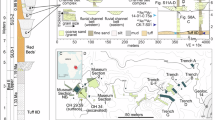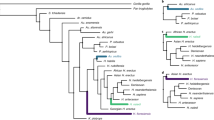Abstract
Some primates, including chimpanzees, throw objects occasionally1,2, but only humans regularly throw projectiles with high speed and accuracy. Darwin noted that the unique throwing abilities of humans, which were made possible when bipedalism emancipated the arms, enabled foragers to hunt effectively using projectiles3. However, there has been little consideration of the evolution of throwing in the years since Darwin made his observations, in part because of a lack of evidence of when, how and why hominins evolved the ability to generate high-speed throws4,5,6,7,8. Here we use experimental studies of humans throwing projectiles to show that our throwing capabilities largely result from several derived anatomical features that enable elastic energy storage and release at the shoulder. These features first appear together approximately 2 million years ago in the species Homo erectus. Taking into consideration archaeological evidence suggesting that hunting activity intensified around this time9, we conclude that selection for throwing as a means to hunt probably had an important role in the evolution of the genus Homo.
This is a preview of subscription content, access via your institution
Access options
Subscribe to this journal
Receive 51 print issues and online access
$199.00 per year
only $3.90 per issue
Buy this article
- Purchase on SpringerLink
- Instant access to full article PDF
Prices may be subject to local taxes which are calculated during checkout




Similar content being viewed by others
References
Goodall, J. The Chimpanzees of Gombe: Patterns of Behavior (Harvard Univ. Press, 1986)
Westergaard, G. C., Liv, C., Haynie, M. K. & Suomi, S. J. A comparative study of aimed throwing by monkeys and humans. Neuropsychologia 38, 1511–1517 (2000)
Darwin, C. The Descent of Man, and Selection in Relation to Sex (John Murray, 1871)
Churchill, S. E. & Rhodes, J. A. in The Evolution of Hominin Diets: Integrating Approaches to the Study of Paleolithic Subsistence (eds Hublin, J. J. & Richards, M. P. ) 201–210 (Springer, 2009)
Larson, S. G. Evolutionary transformation of the hominin shoulder. Evol. Anthropol. 16, 172–187 (2007)
Calvin, W. H. The Throwing Madonna: Essays on the Brain (Bantam, 1983)
Fifer, F. C. The adoption of bipedalism by the hominids: a new hypothesis. Hum. Evol. 2, 135–147 (1987)
Bingham, P. M. Human evolution and human history: a complete theory. Evol. Anthropol. 9, 248–257 (2000)
Stanford, C. B. & Bunn, H. T. in Human Evolution Series (eds Ciochon, R. L. & Wood, B. ) (Oxford Univ. Press, 2001)
Shea, J. J. The origins of lithic projectile point technology: evidence from Africa, the Levant, and Europe. J. Archaeol. Sci. 33, 823–846 (2006)
Hirashima, M., Kadota, H., Sakurai, S., Kudo, K. & Ohtsuki, T. Sequential muscle activity and its functional role in the upper extremity and trunk during overarm throwing. J. Sports Sci. 20, 301–310 (2002)
Fleisig, G. S., Andrews, J. R., Dillman, C. J. & Escamilla, R. F. Kinetics of baseball pitching with implications about injury mechanisms. Am. J. Sports Med. 23, 233–239 (1995)
Pappas, A. M., Zawacki, R. M. & Sullivan, T. J. Biomechanics of baseball pitching. A preliminary report. Am. J. Sports Med. 13, 216–222 (1985)
Dillman, C. J., Fleisig, G. S. & Andrews, J. R. Biomechanics of pitching with emphasis upon shoulder kinematics. J. Orthop. Sports Phys. Ther. 18, 402–408 (1993)
Hirashima, M., Kudo, K., Watarai, K. & Ohtsuki, T. Control of 3D limb dynamics in unconstrained overarm throws of different speeds performed by skilled baseball players. J. Neurophysiol. 97, 680–691 (2007)
DiGiovine, N. M., Jobe, F. W., Pink, M. & Perry, J. An electromyography analysis of the upper extremity in pitching. J. Shoulder Elbow Surg. 1, 15–25 (1992)
Gowan, I. D., Jobe, F. W., Tibone, J. E., Perry, J. & Moynes, D. R. A comparative electromyographic analysis of the shoulder during pitching: professional versus amateur pitchers. Am. J. Sports Med. 15, 586–590 (1987)
Astley, H. C. & Roberts, T. J. Evidence for a vertebrate catapult: elastic energy storage in the plantaris tendon during frog jumping. Biol. Lett. 8, 386–389 (2012)
Patek, S. N., Nowroozi, B. N., Baio, J. E., Caldwell, R. L. & Summers, A. P. Linkage mechanics and power amplification of the mantis shrimp's strike. J. Exp. Biol. 210, 3677–3688 (2007)
Bramble, D. M. & Lieberman, D. E. Endurance running and the evolution of Homo. Nature 432, 345–352 (2004)
Osbahr, D. C., Cannon, D. L. & Speer, K. P. Retroversion of the humerus in the throwing shoulder of college baseball pitchers. Am. J. Sports Med. 30, 347–353 (2002)
Reagan, K. M. et al. Humeral retroversion and its relationship to glenohumeral rotation in the shoulder of college baseball players. Am. J. Sports Med. 30, 354–360 (2002)
Bennett, M. B., Ker, R. F., Dimery, N. J. & Alexander, R. M. Mechanical properties of various mammalian tendons. J. Zool. 209, 537–548 (1986)
Werner, S. L., Fleisig, G. S., Dillman, C. J. & Andrews, J. R. Biomechanics of the elbow during baseball pitching. J. Orthop. Sports Phys. Ther. 17, 274–278 (1993)
Pieper, H. G. Humeral torsion in the throwing arm of handball players. Am. J. Sports Med. 26, 247–253 (1998)
Cowgill, L. W. Humeral torsion revisited: a functional and ontogenetic model for populational variation. Am. J. Phys. Anthropol. 134, 472–480 (2007)
Haile-Selassie, Y. et al. An early Australopithecus afarensis postcranium from Woranso-Mille, Ethiopia. Proc. Natl Acad. Sci. USA 107, 12121–12126 (2010)
Walker, A. & Leakey, R. E. The Nariokotome Homo erectus Skeleton (Harvard Univ. Press, 1993)
Richmond, B. G., Begun, D. R. & Strait, D. S. Origin of human bipedalism: the knuckle-walking hypothesis revisited. Am. J. Phys. Anthropol. 44 (Suppl.). 70–105 (2001)
Snyder, S. J., Karzel, R. P., Del Pizzo, W., Ferkel, R. D. & Friedman, M. J. SLAP lesions of the shoulder. Arthroscopy 6, 274–279 (1990)
Roach, N. T., Lieberman, D. E., Gill, T. J., IV, W. E. & Gill, T. J. III. The effect of humeral torsion on rotational range of motion in the shoulder and throwing performance. J. Anat. 220, 293–301 (2012)
Winter, D. A. Biomechanics and Motor Control of Human Movement 2nd edn (Wiley-Interscience, 1990)
Dempster, W. T. Space Requirements for the Seated Operator (Wright Air Development Center, 1955)
Acknowledgements
We would like to thank the Wyss Institute, L. Stirling, A. Biewener, R. Wrangham, S. Larson, B. Roach, L. Meszoly, A. Lobell and many undergraduate research assistants for their feedback, help and support. Funding was provided by the National Science Foundation (BCS-0961943 to N.T.R. and D.E.L.), the American School for Prehistoric Research (to N.T.R. and D.E.L.) and the Wellcome Trust/DBT India Alliance (500158/Z/09/Z to M.V.).
Author information
Authors and Affiliations
Contributions
N.T.R. and D.E.L. designed the study and wrote the paper. N.T.R. collected and analysed the data with help from D.E.L., M.V. and M.J.R. All authors helped to edit the paper.
Corresponding author
Ethics declarations
Competing interests
The authors declare no competing financial interests.
Supplementary information
Supplementary Information
This file contains Supplementary Notes 1-23, Supplementary Figures 1-8, Supplementary Tables 1-6 and Supplementary References. (PDF 1230 kb)
Rights and permissions
About this article
Cite this article
Roach, N., Venkadesan, M., Rainbow, M. et al. Elastic energy storage in the shoulder and the evolution of high-speed throwing in Homo . Nature 498, 483–486 (2013). https://doi.org/10.1038/nature12267
Received:
Accepted:
Published:
Issue date:
DOI: https://doi.org/10.1038/nature12267
This article is cited by
-
Reassessing the Interpretative Potential of Ethnographic Collections for Early Hunting Technologies
Journal of Archaeological Method and Theory (2023)
-
Free hand hitting of stone-like objects in wild gorillas
Scientific Reports (2022)
-
Current concepts in the diagnosis and treatment of adhesive capsulitis: role of diagnostic imaging and ultrasound-guided interventional procedures
La radiologia medica (2022)
-
Quantifizierung der Belastungen des Muskel-Band-Apparats im Schultergelenk von Speerwerfern
Obere Extremität (2022)
-
Comparing paper level classifications across different methods and systems: an investigation of Nature publications
Scientometrics (2022)




Peter Gibson
The baseball throw appears to be just that and is different from bowling in cricket. The throw sends the ball through the air the parallel to the ground like skimming stones on a pond. This would appear not to be a very effective from the point of view of hitting a target (seen the video). It involves twisting the body (for some reason many women do not naturally throw like men). In cricket (tennis e.g. Wimbledon and the crawl in swimming) the arm is held straight above the head and brought down and forwards (as shown by chimp in video). I assume this is a centrifugal force and is augmented by the weight of the body. An anatomical explanation for throwing (in generic sense) verses bowling appears difficult to justify in evolutionary terms.
Throwing appears to have evolved via brachiating. The arms needed to stretch above the head as in gibbons and orang-utans. These live in the tree canopy and their long arms act as hooks, and the body has a low centre of gravity. In the past the loss of forests due to global warming forced (through completion from other primate) defenceless hominids onto beaches to scavenge. This is the basis of Sir Alister Hardy?s Aquatic Ape theory (Nature-online comment on doi:10.1038/497573a). There was a need to climb vertical cliffs to reach the safety of caves for the night. Climbing vertically is an adaptation of brachiating. This also appears to have lead to an increase in the length and power of the legs to provide upward thrust. This was a pre-adapted to walking (rather than walking preceding long legs). In birds long legs appear to be an adaptation to jumping and wading and a pre-adaption to flying (Science-online comment on doi:10.1126/science.1235463).
From the safety of caves hominids may have thrown rocks from above for defence and to bring down passing game. This would have been a downward stroke rather than a sideways one. The resulting chipped and therefore sharp rocks (cf. knapped) collected from under the cliffs became the first recycled tools. All technology is serendipitous. With the advent of walking early armed hominids moved onto the savannahs to hunt large herbivores which had taken advantage of the grasslands brought about by loss of forests. Cliff dwelling hominids followed them. The armed hominids, able to throw and walk, became effective hunters. The only running required was to assist in throwing. The pitcher in baseball is static and, as Roach et al appears to say, coils like a spring.
All sport (baseball and cricket in particular) may be a re-enactment of hunting and tribal competition. They are ball (rock) games and, as one might guess, played on grass. Overlooking ritual areas (stadia and grounds) are recreated cliffs of seating with high rise housing behind. Fanciful as this sounds the psychiatrist Jung, rival of Freud, believed in ancestral memories. This is a theory of instinct formalised by people such as Tinbergen who came after Jung. This is all a very different view to that of Roach et al but just as convincing.